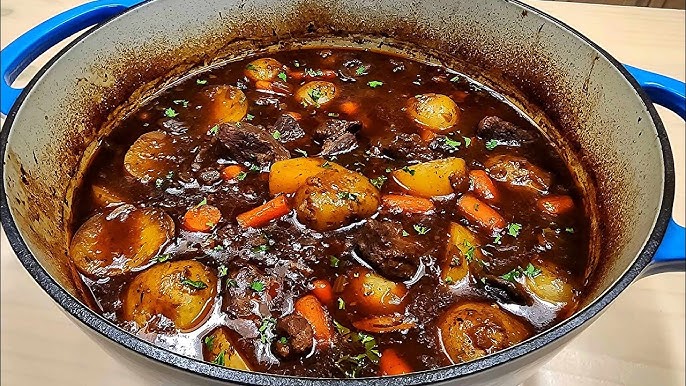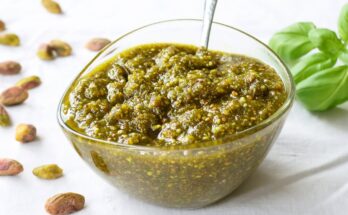Lamb Stew Recipe: If you’re looking for a meal that’s hearty, comforting, and packed full of flavor, lamb stew is your answer. This traditional dish has been enjoyed around the world for centuries, offering a perfect combination of tender meat, rich broth, and a medley of vegetables.
Whether you’re warming up on a cold evening or impressing dinner guests, lamb stew is a timeless classic that never fails to satisfy. Let’s dive into this step-by-step guide to making the best lamb stew you’ve ever had.
Ingredients Needed for Lamb Stew
Before you begin cooking, gathering the right ingredients is crucial. Here’s everything you’ll need:
Main Ingredients
- 2 pounds of lamb shoulder or leg, cut into cubes
- 3 tablespoons of olive oil
- 4 large carrots, peeled and chopped
- 3 potatoes, diced
- 2 onions, finely chopped
- 4 cloves of garlic, minced
- 1 cup of peas
- 1 can of diced tomatoes (14 oz)
- 4 cups beef or lamb stock
Spices and Seasonings
- 1 teaspoon salt
- ½ teaspoon black pepper
- 1 tablespoon paprika
- 2 teaspoons rosemary
- 2 teaspoons thyme
- 2 bay leaves
Optional Add-ons
- 1 cup red wine (for extra depth of flavor)
- 1 tablespoon Worcestershire sauce
- Mushrooms, celery, or parsnips for added variety
Having these ingredients ready will make your cooking process smooth and enjoyable.
Choosing the Right Cut of Lamb
One key to a great stew is picking the right cut of meat.
Best Cuts for Stewing
The best lamb cuts for stews are shoulder, neck, and shank. These cuts are tough with lots of connective tissue, which breaks down beautifully during slow cooking, making the meat incredibly tender and flavorful.
Tips for Tender Lamb
- Trim excess fat: You want rich flavor, not an oily stew.
- Cut uniformly: Ensures even cooking.
- Brown thoroughly: Caramelization brings out deeper flavors.
Preparing the Ingredients
A little preparation goes a long way to making a stew that’s rich and satisfying.
Chopping Vegetables
Dice your vegetables into even pieces. Uniformity ensures they cook evenly and look more appealing in the final dish. Cut carrots into thick coins and potatoes into bite-sized chunks. Onion should be finely diced for maximum flavor infusion.
Marinating the Lamb
Marinating isn’t mandatory, but it elevates the flavor. Simply coat the lamb cubes with a mixture of olive oil, rosemary, thyme, and a pinch of salt and pepper. Let it sit for about an hour if you have time.
Cooking Lamb Stew – Step by Step
Here’s where the magic happens.
Step 1: Browning the Lamb
Heat the olive oil in a large pot or Dutch oven over medium-high heat. Add the lamb cubes in batches—don’t overcrowd the pot. Brown them on all sides. Remove and set aside.
Step 2: Sautéing the Vegetables
In the same pot, add onions and garlic. Sauté for about 5 minutes until they are translucent and aromatic. Then toss in your carrots and potatoes and cook for another 5 minutes.
Step 3: Building the Flavor Base
Return the browned lamb to the pot. Stir in the diced tomatoes, spices, and optional Worcestershire sauce. If you’re using wine, pour it in now and let it reduce for a few minutes.
Step 4: Simmering to Perfection
Add the stock and bay leaves. Bring the mixture to a boil, then reduce the heat to low. Cover and simmer for 1.5 to 2 hours, stirring occasionally. In the last 15 minutes, add the peas so they stay vibrant and tender.
The result? A pot full of melt-in-your-mouth lamb, tender vegetables, and a broth that’s just bursting with flavor.
Tips for a Perfect Lamb Stew
Want to make your lamb stew truly unforgettable? Here are some insider tips that will take your dish to the next level:
- Don’t Rush Browning: Take your time when browning the lamb. A deep golden crust on the meat builds complex flavors in the stew.
- Layer Flavors: Add ingredients gradually rather than dumping everything in at once. This ensures each element has a chance to release its full flavor.
- Low and Slow is Key: Stews are best when cooked at a low temperature over a long time. High heat can make the lamb tough instead of tender.
- Skim the Fat: As the stew simmers, some fat will rise to the top. Skim it off periodically for a cleaner, richer flavor.
- Adjust Seasonings at the End: Flavors concentrate as the stew cooks, so wait until the last 20 minutes to taste and adjust the salt and pepper.
These simple tweaks make a world of difference between an okay stew and one that has everyone asking for seconds!
Serving Suggestions
Lamb stew is incredibly versatile when it comes to serving options. Here are some tasty ideas:
- With Crusty Bread: A warm, crusty baguette is perfect for soaking up that rich broth.
- Over Mashed Potatoes: Ladle the stew over creamy mashed potatoes for a hearty meal.
- Alongside Rice or Couscous: Both absorb the savory juices beautifully.
- With a Simple Green Salad: Balance the richness of the stew with a crisp, fresh salad on the side.
- Garnished with Fresh Herbs: A sprinkle of fresh parsley or thyme just before serving adds a burst of color and freshness.
Choose your favorite or mix and match for a restaurant-quality dining experience at home!
Storage and Reheating Tips
Got leftovers? Lucky you! Lamb stew often tastes even better the next day after the flavors have had time to meld together. Here’s how to handle it:
- Storing: Let the stew cool completely, then transfer it to an airtight container. It will keep in the refrigerator for up to 4 days.
- Freezing: Lamb stew freezes exceptionally well. Pour into freezer-safe containers or heavy-duty bags, and freeze for up to 3 months. Don’t forget to label with the date!
- Reheating: Thaw frozen stew in the fridge overnight. Reheat slowly over low heat on the stove, stirring occasionally, until warmed through. You can also microwave individual portions.
For best results, add a splash of broth or water when reheating to maintain the stew’s luscious consistency.
FAQs about Lamb Stew Recipe
1. What is the best cut of lamb for stew?
The best cuts for lamb stew are shoulder, shank, and neck. These cuts are rich in connective tissue, which breaks down during slow cooking, making the meat tender and flavorful.
2. How long should I cook lamb stew?
Lamb stew usually takes about 2 to 3 hours to cook on low heat. The key is slow cooking to allow the meat to become melt-in-your-mouth tender and the flavors to blend beautifully.
3. Can I make lamb stew ahead of time?
Absolutely! In fact, lamb stew often tastes even better the next day after the flavors have had more time to develop. Simply refrigerate it overnight and reheat gently before serving.
4. What vegetables go well in lamb stew?
Classic choices include carrots, potatoes, onions, and peas. You can also add mushrooms, celery, or parsnips to enhance the flavor and texture of your stew.
5. How do I thicken lamb stew?
To thicken your stew, you can mash a few potatoes directly into the broth or mix a tablespoon of flour or cornstarch with water and stir it in during the last 10–15 minutes of cooking.
6. Can I freeze lamb stew?
Yes! Lamb stew freezes very well. Let it cool completely, store it in airtight containers, and freeze for up to 3 months. Thaw overnight in the fridge before reheating.
7. What herbs and spices are best for lamb stew?
Rosemary, thyme, bay leaves, garlic, and paprika pair beautifully with lamb. A pinch of cumin or cinnamon can also add a lovely depth of flavor.
Conclusion
There’s nothing quite like a bowl of homemade lamb stew—rich, hearty, and filled with soul-warming goodness. With this detailed step-by-step guide, you now have all the tools you need to create a dish that will delight family and friends alike. Remember, the secret to a truly great stew lies in the patience and love you pour into each step, from browning the meat to the final simmer. Happy cooking!



